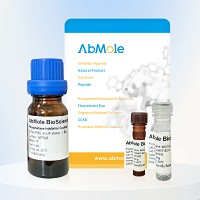All AbMole products are for research use only, cannot be used for human consumption.

Species: Human
Expression system: E.coli
Purity: > 95% as determined by reduced SDS-PAGE
Endotoxin: LAL test measured less than 0.1 ng/µg (1EU/µg)
Molecular weight: 11.7 KDa
Storage and stability: The freeze-dried protein should be stored at ≤-20°C for one year after receiving. The recombinant protein solution can be stored at 2-8℃ for 2-7 days. The bisector of the recombinant sample was stable at ≤-20°C for 3 months.
Bioactivity: S100A11 is a member of the calcium-binding protein S100 family. Human S100A11 contains two EF hand motifs, 82% of which share the same amino acid sequence as mouse and rat S100A11. It forms a covalent homodimer and a disulfide tetramer under the action of transglutamine. S100A11 is secreted by keratinocytes and can be cross-linked into the keratinocyte envelope of the skin. Dimerization enhances its ability to signal keratinocytes via RAGE, induce EGF family protein production, and induce cell proliferation. Dimerization also causes S100A11 to bind to RAGE on chondrocytes, leading to chondrocyte hypertrophy and catabolism of cartilage matrix. In addition, S100A11 is found in the cytoplasm and is phosphorylated and transferred to the nucleus in response to DNA damage, RELM alpha exposure, or elevated extracellular calcium concentrations. Calcium also promotes the binding of S100A11 to S100B and to annexins A1, A2 and A6. The S100A11-Annexin A2 complexes are recruited to sites of plasma membrane damage where they promote membrane repair of migrating cancer cells. S100A11 is upregulated in various cancers, supporting tumor cell proliferation, invasion and migration. In addition, S100A11 is produced in the ovary and acts on cumulus cells to inhibit oocyte fertilization.
| Solubility (25°C) | Always centrifuge tubes before opening.Do not mix by vortex or pipetting. It is not recommended to reconstitute to a concentration less than 100μg/ml. |
| Storage |
Powder -20°C 3 years ; 4°C 2 years In solvent -80°C 6 months ; -20°C 1 month |
| Related Cytokines and Growth Factors Products |
|---|
| Recombinant Human GDF-15 Protein (HEK293 N-hFc)
Growth-differentiation factor 15 (GDF15), also known as MIC-1, is a secreted member of the transforming growth factor (TGF)-β superfamily. GDF-15 has a role in regulating inflammatory and apoptotic pathways in injured tissues and during disease processes. GDF-15 overexpression arising from an expanded erythroid compartment contributes to iron overload in thalassemia syndromes by inhibiting hepcidin expression. |
| Recombinant Human FGFR1 Protein (HEK293, C-His)
FGFR1, also known as CD331, is a full-length representative protein consists of an extracellular region, composed of three immunoglobulin-like domains, a single hydrophobic membrane-spanning segment and a cytoplasmic tyrosine kinase domain. |
| Recombinant Human FGFR2 Protein (HEK293, C-His)
FGFR2, also known as CD332, acts as cell-surface receptor for fibroblast growth factors and plays an essential role in the regulation of cell proliferation, differentiation, migration and apoptosis, and in the regulation of embryonic development. FGFR2 plays an essential role in the regulation of osteoblast differentiation, proliferation and apoptosis, and is required for normal skeleton development. It also promotes cell proliferation in keratinocytes and imature osteoblasts, but promotes apoptosis in differentiated osteoblasts. |
| Recombinant Mouse BMP-4 Protein (E. coli, C-His)
Bone Morphogenetic Protein-4 (BMP-4) is a critical signaling molecule required for the early differentiation of the embryo and establishing of a dorsal-ventral axis. BMP-4 is secreted from the dorsal portion of the notochord, and it acts in concert with sonic hedgehog to establish a dorsal-ventral axis for the differentiation of later structures. |
| Recombinant Human Coagulation Factor X (HEK293, C-Fc)
Coagulation factor X, belongs to the peptidase S1 family. Coagulation factor X is initially synthesized in the liver. Coagulation factor X is a vitamin K-dependent glycoprotein that converts prothrombin to thrombin in the presence of factor Va, calcium and phospholipid during blood clotting. |
All AbMole products are for research use only, cannot be used for human consumption or veterinary use. We do not provide products or services to individuals. Please comply with the intended use and do not use AbMole products for any other purpose.


Products are for research use only. Not for human use. We do not sell to patients.
© Copyright 2010-2024 AbMole BioScience. All Rights Reserved.
